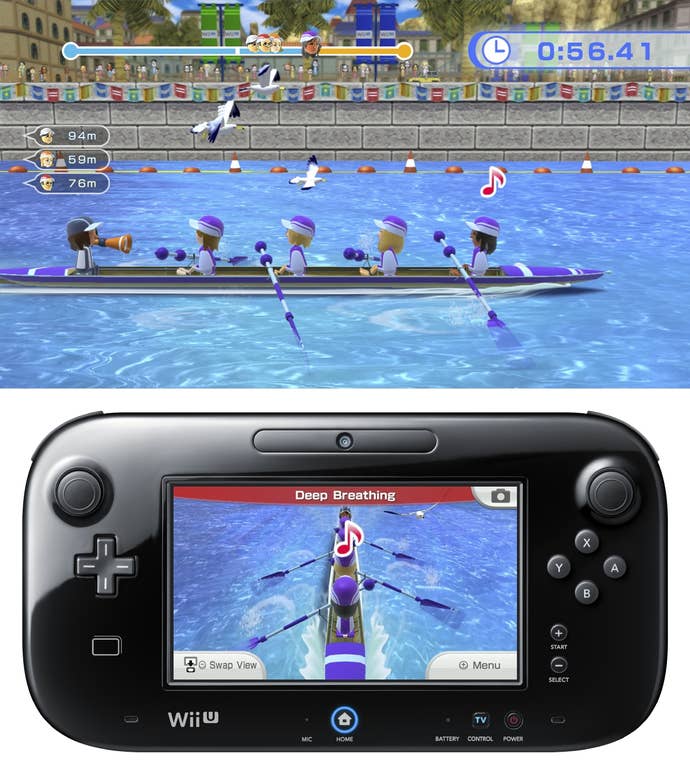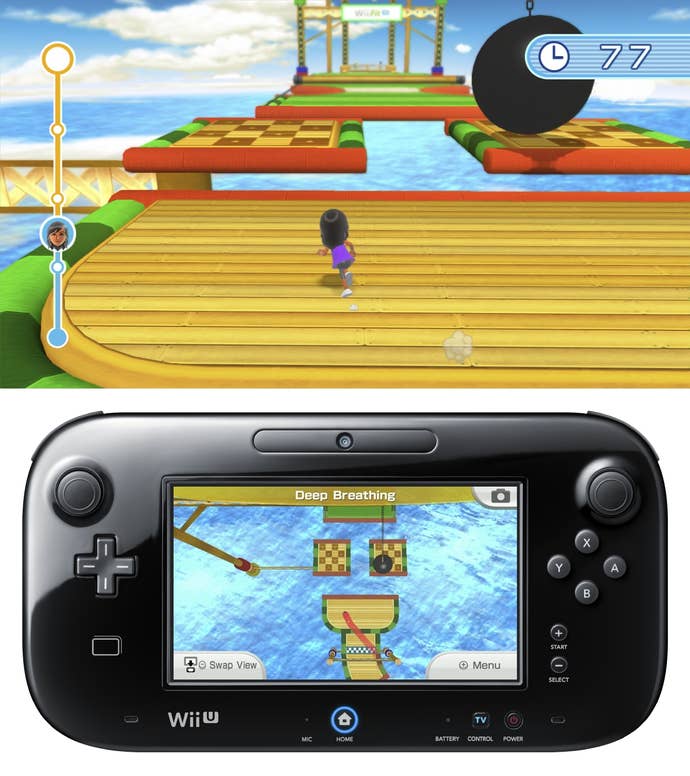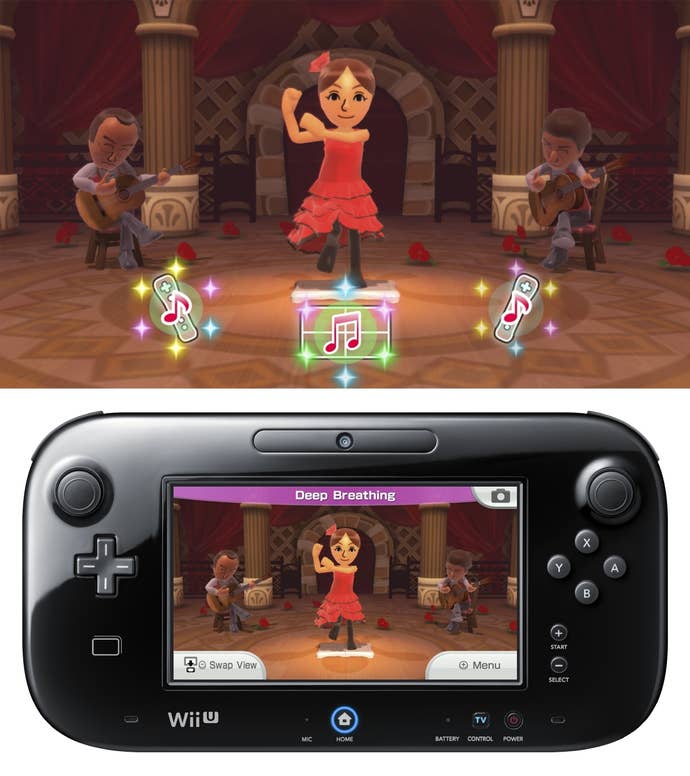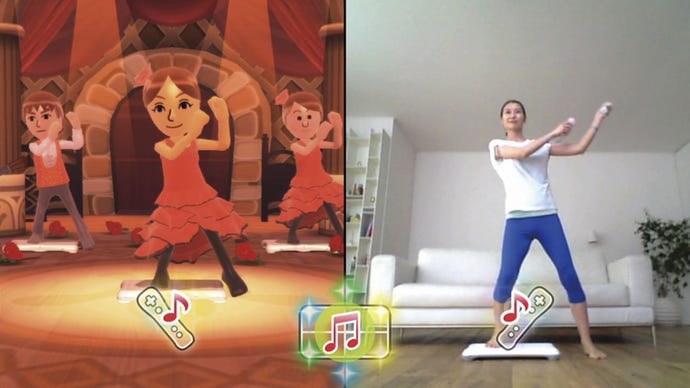New Year, New U: Wii Fit U Review
Can Nintendo's latest take on its popular exercise-at-home program make working out fun?
This article first appeared on USgamer, a partner publication of VG247. Some content, such as this article, has been migrated to VG247 for posterity after USgamer's closure - but it has not been edited or further vetted by the VG247 team.
Losing weight or getting fit is, without a doubt, one of the most common new year's resolutions there is.
It's understandable, of course; the excesses generally indulged in over the festive season tend to be rather unkind to one's waistline, and the beginning of a new year is as good a time as any to try and get into good habits.
Over time, the excuses start to appear, though. It's too expensive to go to the gym; it's too far away; it's embarrassing to work out in front of others; it's demoralizing to see people much fitter than you doing much better than you.
If you've ever thought any of those things, Wii Fit U is aimed squarely at you. But there's plenty to like here, even for those who take a deeper enjoyment in fitness as a hobby rather than simply as a means to try and shed a few turkey pounds.
Wii Fit U's biggest strength is in its flexibility. Between the exercises built into the software and the separate Fit Meter device, you can make use of it to track your activity levels and calories burned over a variety of exercises -- even those you're not actively using the software for.
The Fit Meter is a small Fitbit-style device that clips on to your belt. Once you've paired it with one of the users of the Wii Fit U software -- if your whole family is using it, you'll need one each -- it begins tracking your activity on a daily basis, including number of steps taken, how "active" those steps were (i.e. whether you were walking slowly or running fast, or anything in between) and your changes in altitude over the course of the day. Sync the device with Wii Fit U by using the infra-red connection with the Wii U GamePad and you'll be able to track your progress both in terms of various walking courses and various climbs -- over time you'll be able to do everything from walking around the Equator to climbing the Statue of Liberty -- and the calories you burned with the Fit Meter are credited to your daily workout.
It's once you're into the software itself that things get interesting, though. There are a variety of different activities available, and a variety of means of getting to them.

The simplest approach is simply to pick what activity you want to do. All are available at any time, though in most cases you have to unlock harder difficulties or longer endurance periods by completing the lower difficulties a few times first. This allows inexperienced athletes to ease themselves into working out gently, but may prove frustrating to those who are simply using it to support an existing fitness regime.
Alternative approaches to the exercises include choosing preset workouts, or making use of a Personal Trainer mode to devise a workout based on how long you want to work out or how many calories you want to burn, how intense you want the activity to be, and specific areas of your body you wish to work on. Once you've been using the software a while, you can also track how much time you've been spending on each area of your body, too, and the software can recommend exercises that are particularly good for various areas you either want to develop further, or make up for underuse of.
The exercises themselves run the gamut from more conventional muscle exercises to more game-like activities. As in previous versions of the software, there's a marked distinction between the rather bland, no-nonsense visuals of the yoga and muscle workout activities and the colorful, joyful, Mii-filled environments of the more "gamey" exercises. This isn't to say the latter are in any way less "hardcore" than the straightforward muscle and yoga workouts, however; many of them offer a significant challenge, particularly if you're looking for an aerobic workout.
The muscle and yoga exercises are simply implemented, mostly making use of the Wii Balance Board to track your weight distribution and stability as you complete the exercises. The trainers offer regular, albeit repetitive, encouragement as you work your way through each program, and advice if you're struggling. For those who wish to keep an eye on their form, a new addition to Wii Fit U over its predecessors allows you to make use of the GamePad's front-facing camera to show yourself on screen and compare what you're doing with what the trainer is demonstrating. For those who find such a prospect utterly horrifying, however -- I'm one of those people -- you'll be pleased to know that this feature is turned off by default.

The other exercises are split into several different categories, each of which is rated with a "MET" value to determine how intense the activity is -- the higher, the harder you'll have to work and the more calories you'll burn.
Aerobic exercises range from simple jogging (actually running on the spot with a Wii Remote in your pocket) to cycling (repeatedly "pedalling" on the Wii Balance Board while "steering" with a sideways Wii Remote as your handlebars) and rowing, which can either be performed sitting in a chair with your feet on the Wii Balance Board or sitting on the Wii Balance Board itself according to your own flexibility. Most of the aerobic activities can be used to work up a pretty good sweat -- particularly if you put plenty of effort into your movements. For fatties like me, jogging is probably the most challenging over a long period, but it's also the most tedious and the hardest on your feet; active games such as the excellent Puzzle Squash are more fun but perhaps present a somewhat less intense workout, while the two Obstacle Course games see you effectively playing a Super Mario 3D World level with your feet.
Balance exercises are the most "game-like" of all the activities, and tend to involve accurately shifting your weight around on the Wii Balance Board in order to achieve specific goals. In one game, for example, you're rolling balls into correctly-colored pipes, while in another you're using the Wii U GamePad as a tea tray in order to carry desserts to diners at a dinner party.
Finally, the new Dance activities get you moving through a series of choreographed routines in a variety of styles. You'll need two Motion Plus-equipped Wii Remotes (or Wii Remote Plus) to participate in these activities, since they make use of both your arms and legs. The routines range from a simple beginner dance that looks utterly ridiculous but at least introduces you to the concept of making your arms and legs work independently from one another to more complex routines based on hula, hip-hop, locking, salsa and flamenco styles. In each case, you begin by being walked through the routine a step at a time by a friendly Mii instructor, then offered the opportunity to run through the whole thing without stopping. When you've successfully completed this a couple of times, an advanced routine unlocks and works in the same way. There's also a Stamina Steps option that makes use of a simple routine over a long period of time, which is good for a protracted aerobic workout if you're bored of jogging.

The Dance routines are something of a highlight, so long as you're not too self-conscious about them. As the instructors note, you get a much better workout from making bigger movements, and they're right -- it's also more fun once you get over that initial "what on Earth am I doing?" phase and into the probably ill-advised "hey, I actually look pretty cool" stage. It's hard to deny a feeling of smug satisfaction as you pull off a locking routine with a 100% accuracy rating, however -- and even harder to resist showing off your moves the next time you're out on the town.
Aside from the activities themselves, Wii Fit U also offers its usual daily Fitness Test option, which encourages you to check your weight every day and makes you more aware of how it fluctuates up and down over time rather than proceeding on a linear path towards your goal. To support your weight loss efforts, the calorie-counting functions in the game allow you to relate the number of calories burned to different foodstuffs, or even to devise a workout designed specifically to burn off something you've eaten or are planning to eat. The Fitness Test also checks your balance and mental agility using a variety of different means and culminates with a fairly meaningless appraisal of your "Wii Fit Age," much as in previous versions of the software.
MiiVerse integration is pretty solid, allowing you to join a dedicated community for your specific goals and then populating your software's main plaza with fellow fitness buffs that you can click on and easily offer words of encouragement to. Your activity is also automatically posted to MiiVerse -- perhaps a little overenthusiastically -- but it provides a means of keeping track of what you're doing, and for friends and fellow athletes to compete against one another. You can also manually post to MiiVerse from the results screen of any activity -- plus of course you can use the Wii U's built-in screenshot function (press the Home button and go to MiiVerse from the menu to automatically attach an image of what you were doing) to share specific on-screen achievements.

On the whole, Wii Fit U is a very solid package that achieves its primary goal of making you more aware of your fitness, how your body works and what you might need to do to make it work better. Its game-like nature and Nintendo charm keeps it interesting, enjoyable and never demoralizing. Some may find its overly positive tone a little patronizing at times, but for those who have struggled to get on with more difficult fitness programs such as EA Sports Active or Your Shape it's an ideal entry into the world of working out -- and the addition of the Fit Meter to the mix means it can form part of a larger routine if you so desire.
Is it worth it for those who still make regular use of Wii Fit or Wii Fit Plus, however? Well, you can transfer your data across from either of the original Wii games -- assuming you've transferred said Wii data to your Wii U beforehand, of course -- and pick up where you left off without a hitch. And while many of the activities are recycled from the previous two versions without much in the way of graphical improvements besides a jump to HD resolution, the new activities are enjoyable enough to make up for this. Do bear in mind that in order to get the most from the game, you will need two Motion Plus-equipped Wii Remotes, however -- and not just for the dancing. These are worth investing in if you don't have them already, anyhow, since even older activities like Rhythm Boxing have been improved to make use of two Wii Remotes rather than the occasionally dodgy motion detection of the Nunchuk, and provide a better experience accordingly. The addition of off-screen play for most activities is excellent, too -- for more lengthy, boring activities such as step aerobics and jogging, you can make the GamePad your main screen and switch your TV over to something a bit more interesting while you work out.
In short, then, Wii Fit U applies that Nintendo magic to something that will get you up on your feet and moving around -- and it'll help you have fun working out. If you've struggled to find a fitness program that's quite right for you -- or if you've never tried one of these fitness games before -- Wii Fit U is a great place to start. If you already have a Wii Balance Board, download and enjoy the 31-day free trial from the eShop before January 31 and purchase a Fit Meter to unlock the full software before your timer expires. If you don't, retail copies of the game come with both a Fit Meter and a Balance Board so you can get started right away.
The Nitty Gritty
- Visuals: Recognizably Nintendo throughout, with plenty of color and charm -- though both the yoga and muscle workout sections are inconsistent with the rest of the game and rather bland, albeit very clear. Returning exercises from the previous two versions haven't had an improvement in visuals beyond an HD upscale.
- Music and Sound: Some catchy background tunes in the more "gamey" activities, while the more "serious" yoga and muscle workouts keep sound to a minimum. Helpful voice prompts help you out in more complex exercises.
- Interface: Simple, intuitive and easy to get where you want to be, whether you're using Wii Remotes or the GamePad for navigation.
- Lasting Appeal: Wii Fit U will last as long as your motivation does. MiiVerse connectivity means you can work together with friends on your fitness goals, which in turn may keep you playing longer. It'd perhaps be nice to see some additional games and exercises added over time, but at present that doesn't look likely.
ConclusionWhile the majority of Wii Fit U isn't as "hardcore" as some fitness buffs may like, it does provide an enormously friendly, approachable entry point into the world of exercise for those who may have struggled with motivation in the past. Featuring a swathe of enjoyable games and a wealth of helpful advice, it's a great starting point on a journey towards a leaner, meaner you.








